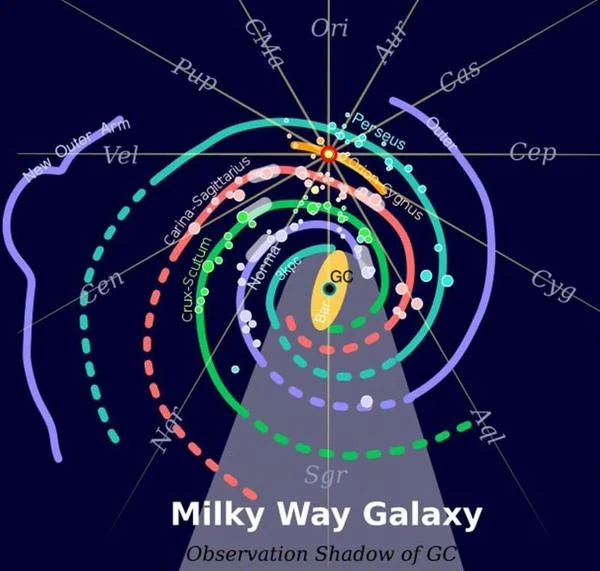
Our galaxy, the Milky Way, is a barred spiral galaxy, meaning it consists of a central bulge of stars, a bar of stars crossing this bulge, and a flat disk surrounding everything. It is within this disk that the galactic arms are found, these bright spiral structures that we observe in other galaxies. These arms are not rigid structures, but rather areas of higher density where stars, gas, and dust accumulate. Our solar system is located in one of these arms, the Orion Arm, between the Perseus Arm and the Sagittarius Arm.
The spiral arms of our galaxy are like denser bands where there are more stars, gas, and dust. Physically, this means that matter is not uniformly distributed, but forms concentrated regions that rotate around the galactic center. To understand how these arms form and evolve, we must study how the galaxy's disk, which rotates on itself, remains stable or not, how density waves can appear, and how gas and stars are born and interact in these zones.
To trace the arms, astronomers use several "indicators": atomic gas detected via a radio wave called 21 cm, molecular gas (mainly CO), star-forming regions (H ii regions), and groups of young stars. By combining precise measurements of velocity, distance, and position (for example with the Gaia satellite or very fine measurements called masers), we can map the shape of the arms. These often resemble logarithmic spirals, i.e., curves that wind around the center in a regular manner, defined by an opening angle called the "pitch angle".
The galactic disk is modeled as a rotating fluid under its own gravity. The speed at which stars and gas rotate depends on the gravitational force pulling them toward the center. This circular velocity \(v_c(R)\) is related to the slope of the gravitational potential. To determine if the disk is stable or if it will collapse locally (thus forming arms or clusters), we use a criterion called the Toomre parameter \(Q\). It depends on the density of matter, the speed of sound in the gas (which reflects pressure or turbulence), and orbital dynamics. When \(Q\) is less than 1, the disk becomes unstable and can form structures like arms.
The existence of spiral arms has long intrigued astronomers. Two main theories attempt to explain their formation and persistence.
These two theories are not mutually exclusive, and it is possible that both contribute to the formation and dynamics of galactic arms.
Thanks to very precise techniques, such as position and movement measurements of stars with the Gaia satellite or very fine radio observations of masers, astronomers can now build a 3D map of the Milky Way and precisely measure the velocities of the objects within it. These new data show that our galaxy has both stable spiral arms, which resemble global waves, and more temporary structures that appear locally. This gives a complex but logical picture, where several phenomena combine to shape the spiral arms we observe.
From a mechanical point of view, spiral arms result from a compromise between collective modes (density waves) and transient local phenomena amplified by shear and dissipation in the gas. The Milky Way seems to combine these two mechanisms, explaining the complexity of its spiral structure. A multi-tracer and multi-scale approach is essential to decipher galactic dynamics.
The Milky Way has four major spiral arms: the Perseus Arm, the Norma-Cygnus Arm, the Sagittarius-Carina Arm, and the Orion Arm (where our solar system is located). Contrary to popular belief, stars do not remain fixed in these arms but pass through them during their galactic orbit, at an average speed of 220 km/s.
| Arm Name | Length (light-years) | Estimated Mass (solar masses) | Star Formation Rate |
|---|---|---|---|
| Perseus Arm | ∼ 25,000 | 2 × 109 | 0.5 stars/year |
| Sagittarius-Carina Arm | ∼ 20,000 | 1.5 × 109 | 0.8 stars/year |
| Orion Arm (local) | ∼ 3,500 | 3 × 108 | 0.1 stars/year |
| Norma-Cygnus Arm | ∼ 18,000 | 1.8 × 109 | 0.6 stars/year |
| Cygnus-Sagittarius Arm | ∼ 15,000 | 1.2 × 109 | 0.4 stars/year |
| Scutum-Crux Arm | ∼ 18,000 | 1.6 × 109 | 0.7 stars/year |
| Centaurus Arm | ∼ 12,000 | 9 × 108 | 0.3 stars/year |
| Orion Spur | ∼ 5,000 | 4 × 108 | 0.2 stars/year |
Source: NASA Spitzer Space Telescope and ESO Galactic Structure Studies.
In about 4 billion years, the Milky Way will collide with the Andromeda galaxy. This major gravitational interaction will radically alter the structure of our spiral arms, likely transforming them into an elliptical galaxy. Numerical simulations suggest that the probability of a direct stellar collision remains infinitesimal, on the order of \(10^{-12}\) per star.